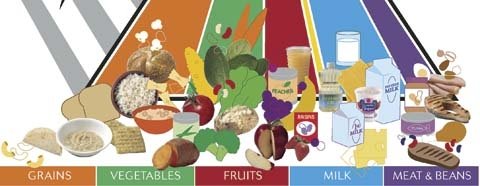
The revised USDA food pyramid includes greater emphasis on fruit.
Just a few years ago, all that buyers cared about was the appearance of the apples they bought. “You never talked about taste when you sold an
apple,” recalled Robert Kershaw, president of Domex Marketing Company, Inc., Yakima, Washington. “The retailers were promoting appearance, and no one cared about anything else.”
Then, buyers started talking about taste and flavor, and now they’re becoming concerned about the nutritional value of produce, Kershaw said during a discussion at the Washington State Horticultural Association convention.
“It’s my guess, with the obesity problem in the United States, that five to ten years from now it might be nutrition first, then taste and texture, and appearance last,” he said.
Domex Marketing and other leading marketers are working with the Produce for Better Health Foundation and others to increase sales by focusing on the role of fruit in tackling the country’s health and obesity problems, he said.
The blueberry and pomegranate industries have had success touting the benefits of the antioxidants they contain, he noted, and producers of apples and cherries can make similar claims.
“It’s easy to get retailers to jump on board because they can see the profitability of that. The whole marketing approach has flip-flopped. Appearance is a given. It has to be right. The other things are what we’re really focusing on now.”
Motivate
Ned Rawn, business manager for fresh slices at the processor Tree Top, Inc., Selah, Washington, said the three major drivers in the food industry have been health, convenience, and brand, and health has consistently come to the top of people’s minds. People are more concerned about what they’re eating.
“We’re just now learning the health attributes and how to present them to the consumer so they can understand them and it will motivate them to purchase,” he said. “As marketers we need to look at developing a strong health message. I think it’s limitless in terms of what we can do. We’re starting to scratch the surface.”
According to Elizabeth Pivonka, president of the Produce for Better Health Foundation, heart disease, cancer, stroke, and diabetes—which are among the leading causes of death—are all related to insufficient fruits and vegetables in the diet and a lack of exercise. Much more money is being spent to treat such diseases than on prevention, and health costs continue to rise.
Pivonka said heavy advertising and marketing for other snacks and drinks are among the reasons people don’t eat more fruits and vegetables. For example, Pepsi spends $2.2 billion a year on advertising, and Mars spends $80 million to advertise M&Ms. In comparison, the Produce for Better Health Foundation’s annual budget is $6 million.
Even the U.S. Department of Agriculture spends far more to promote other agricultural products, such as meat, fish, eggs, and dairy, than on promoting consumption of fruits and vegetables, she said.
The USDA recently revised the food pyramid, showing recommended servings of various foods. Pivonka said the research behind the pyramid was right on track, in terms of recommending that people eat more fruits and vegetables, but the new pyramid graphic did not convey that very well. Kershaw attributed that to lobbying by other agricultural groups that wanted more prominence in the pyramid.
The Produce for Better Health Foundation runs the produce industry’s 5 A Day program, which promotes increased consumption of fresh produce. In fact, half of a person’s daily food consumption should consist of fruits and vegetables, she said, and the foundation is developing a new brand to replace 5 A Day that will encourage people to step up their fruit and vegetable consumption even further.
Asked what kind of research fruit commodity groups could be pursuing in order to enhance their health claims, Pivonka said health messages are important, but producers shouldn’t stake their whole future on them. Focus groups with consumers show that most people know fruits and vegetables are good for them. Information about additional health benefits piques their interest, but what they need to know is how to fit them into their lifestyle. Pivonka said fruits and vegetables are inexpensive enough that most can eat a healthy diet within a budget. An apple costs a third as much as a candy bar. Fruits and vegetables are only expensive if people have to throw them away.
With pears, for example, they need to know how to ripen them properly.
She suggested that the apple industry could provide more recipe ideas showing new ways to use apples. “There are only so many apples you can eat before you want to do something different with them,” she commented.
Reinvent apple
Blair McHaney, co-owner of Get Fit Foods, Wenatchee, Washington, said that in order to increase apple consumption it’s important to reach people who aren’t currently eating them. Value-added products, such as fresh-sliced apples, that are sold in different outlets, are a way to accomplish this. For example, there are 30,000 commercial health clubs in the United States. These are places where produce is not normally seen, but where there are opportunities to get people to start eating apples.
Asked if there’s danger of overdoing the health message, McHaney said he didn’t think it would happen for a while. Sixty-seven percent of the population is overweight or obese. Many billions of dollars are spent on weight-loss products, while the real solution sits in the produce department. “The context in which you are doing your marketing is changing,” he said. “Your message fits the context now.”
McHaney asked the audience to imagine they worked for Mars and had invented the apple. They’d tell management they’d invented an incredible snack that was healthy, full of fiber, and unlike any other product.
“How would you market this snack? Because that’s the nonconsumer of this product—all those people who are spending all their money in the snack industry. The healthy messaging—I think it’s going to be a long time before it’s overdone.”

Leave A Comment